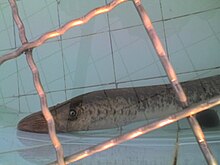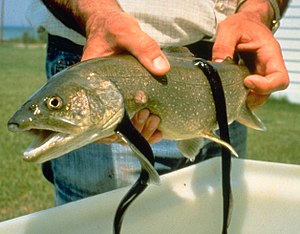Source: Wikipedia
Lampreys (sometimes also called
lamprey eels) are jawless fishes, whose adults are characterized by a toothed, funnel-like sucking mouth. Translated from
Latin, lamprey means stone lickers (
lambere: to lick, and
petra: stone). While lampreys are well known for those species which bore into the flesh of other fish to
suck their blood, most species of lamprey are non-parasitic and never feed on other fishes
[2]. In
zoology, lampreys are sometimes not considered to be true
fish because of their distinctive
morphology and
physiology.
Lampreys live mostly in coastal and fresh waters, although some
species, (e.g.
Geotria australis,
Petromyzon marinus,
Entosphenus tridentatus) travel significant distances in the open ocean, as evidenced by their lack of reproductive isolation between populations. They are found in most temperate regions except those in
Africa. Their
larvae have a low tolerance for high water temperatures, which may explain why they are not distributed in the
tropics.
Adults physically resemble
eels, in that they have no
scales, and can range anywhere from 13 to 100 centimetres (5 to 40 inches) long. Lacking
paired fins, adult lampreys have large eyes, one nostril on the top of the head, and seven
gill pores on each side of the head. The unique morphological characteristics of lampreys, such as their
cartilaginous skeleton, suggest that they are the sister taxon (see
cladistics) of all living jawed vertebrates (
gnathostomes), and are usually considered the most basal group of the Vertebrata. They feed on prey as adults by attaching their mouthparts to the target animal's body, then using their teeth to cut through surface tissues until they reach blood and body fluid. They will generally not attack humans unless starved.
[3][4] Hagfish, which superficially resemble lampreys, are the sister taxon of the true vertebrates (lampreys and gnathostomes).
[4]
Lampreys provide valuable insight into the evolution of the
adaptive immune system, as they possess a convergently evolved
adaptive immunity with cells that function like the
T cells and
B cells seen in higher vertebrates. Lamprey leukocytes express surface Variable Lympocyte Receptors (VLRs) generated from somatic recombination of
leucine-rich repeats gene segments in a
recombination activating gene-independent manner.
[5]
Geotria australis larvae also has a very high tolerance free
iron in the body, and have well-developed biochemical systems for detoxification of the large quantities of this
metal[6].
Relation to humans
Uses

Larger lamprey in a restaurant tank waiting to be cooked and served.

Portuguese Lamprey rice.
Lampreys have long been used as
food for humans. They were highly appreciated by ancient
Romans. During the
Middle Ages, they were
widely eaten by the
upper classes throughout
Europe, especially during
fasting periods, since their taste is much meatier than that of most true fish. King
Henry I of England is said to have died from eating "a surfeit of lampreys".
[15] On 4 March 1953, the
Queen of the United Kingdom's coronation pie was made by the Royal Air Force using lampreys.
[citation needed] Especially in southwestern Europe (
Portugal,
Spain, and
France), larger lampreys are still a highly prized
delicacy. Overfishing has reduced their number in those parts. Lampreys are also consumed in
Sweden,
Finland,
Russia, the
Baltic countries and
South Korea.
In
Britain, lampreys are commonly used as
bait, normally as dead bait.
Pike,
perch and
chub all can be caught on lampreys. Lampreys can be bought frozen from most bait and
tackle shops.
Lampreys are used as a
model organism in biomedical research where their large reticulospinal
axons are used to investigate
synaptic transmission.
[16] The axons of lamprey are particularly large and allow for
microinjection of substances for experimental manipulation.
As pests
Sea lampreys have become a major
plague in the North American
Great Lakes after artificial
canals allowed their entry during the early 20th century. They are considered an
invasive species, have no natural enemies in the lakes and prey on many species of commercial value, such as
lake trout. Since the majority of North American consumers, unlike Europeans, refuse to accept lampreys as food, the Great Lakes fishery has been adversely affected by their invasion. Lampreys are now found mostly in the
streams that feed the lakes, with special barriers to prevent the upstream movement of adults, or by the application of toxicants called
lampricides, which are harmless to most other aquatic species. However those programs are complicated and expensive, and do not eradicate the lampreys from the lakes but merely keep them in check. New programs are being developed including the use of chemically
sterilized male lamprey in a method akin to the
sterile insect technique. Research currently under way on the use of
pheromones and how they may be used to disrupt the life cycle (Sorensen,
et al., 2005) has met with some success.
[17] Control of
sea lampreys in the Great Lakes is conducted by the
U.S. Fish and Wildlife Service and the
Canadian Department of Fisheries and Oceans. The work is coordinated by the
Great Lakes Fishery Commission.
Lake Champlain, bordered by
New York State,
Vermont, and
Quebec, and New York's
Finger Lakes are also home to populations of sea lampreys whose high populations have warranted control. Lake Champlain's lamprey control program is managed by the New York State Department of Environmental Conservation, the Vermont Department of Fish and Wildlife, and the U.S. Fish and Wildlife Service. New York's Finger Lakes sea lamprey control program is managed solely by the New York State Department of Environmental Conservation.


















